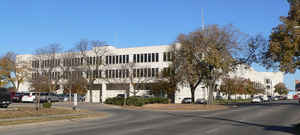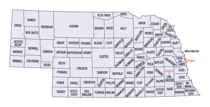Nebraska Counties
There is ninety-three counties in state of Nebraska. Despite the fact that Sarpy County contained the oldest settlement in the state, it was one of the last lands along the river to be recognized by law. Finally, on February 1, 1857, the land "where the cities meet the country" was officially created.Lancaster County, Nebraska
Lancaster County Education, Geography, and History
Lancaster County is a county located in the state of Nebraska. Based on the 2010 census, the population was 285,407, making it the
second-most populous county in Nebraska. Its county seat is Lincoln, the state capital. The county was created in 1859, and the original
county seat was the village of Lancaster.
Lancaster County is part of the Lincoln, NE Metropolitan Statistical Area
Etymology - Origin of Lancaster County Name
Lancaster would eventually become known as Lincoln, in honor of President Abraham Lincoln, while the county would retain the name Lancaster, after Lancaster, Pa., and Lancaster, England.
Demographics:
County QuickFacts: CensusBureau Quick Facts
Lancaster County History
In 1856 a government surveying party
made a discovery that would lead the way to the organization of Lancaster
County. As the surveyors crossed the rolling hills they encountered a wide creek
that, upon closer examination, revealed a series of salt basins stretching more
than six miles in a northeasterly direction. The creek would become known as
Salt Creek and the value of these salt basins, some of which measured one mile
in diameter, was quickly realized. Great wealth was anticipated for those who
could create a suitable operation for harvesting the salt.
The years that followed yielded little progress and it was not until passage of
the Homestead Act that settlers began making their way to the area.
Lancaster County's boundaries were first established by the Territorial
Legislature in 1855 and redefined the following year. When organization efforts
were conducted, a settlement known as Lancaster was named as the county seat.
Lancaster would eventually become known as Lincoln, in honor of President
Abraham Lincoln, while the county would retain the name Lancaster, after
Lancaster, Pa., and Lancaster, England.
As with many other counties, the railroads played an important part in the
area's early development. But what possibly helped the area the most was when
Nebraska was admitted to the Union in 1867 and the quiet village of Lancaster
was selected to become the home of the State Capitol. What followed were years
of growth and prosperity.
A developing agricultural base throughout the county led to Lincoln's growth as
a retail hub. Education quickly followed with the University of Nebraska being
created. Today there are five universities and colleges in Lincoln.
Manufacturing is also an integral part of today's economy.
The growth of the county and Lincoln resulted in voters approving in 1965 the
construction of one building to house both bodies of government. Approximately
four years later the County-City Building was officially opened and still houses
most of the county and city government offices.
Geography: Land and Water
As reported by the Census Bureau, the county has a total area of 846 square miles (2,190 km2), of which 838 square miles (2,170 km2) is
land and 8.8 square miles (23 km2) (1.0%) is water.
Neighboring Counties
Bordering counties are as follows:
- Saunders County - (north)
- Cass County - (northeast)
- Otoe County - (southeast)
- Johnson County - (southeast)
- Gage County - (south)
- Saline County - (southwest)
- Seward County - (northwest)
- Butler County - (northwest)
Education







